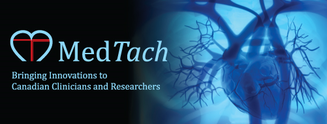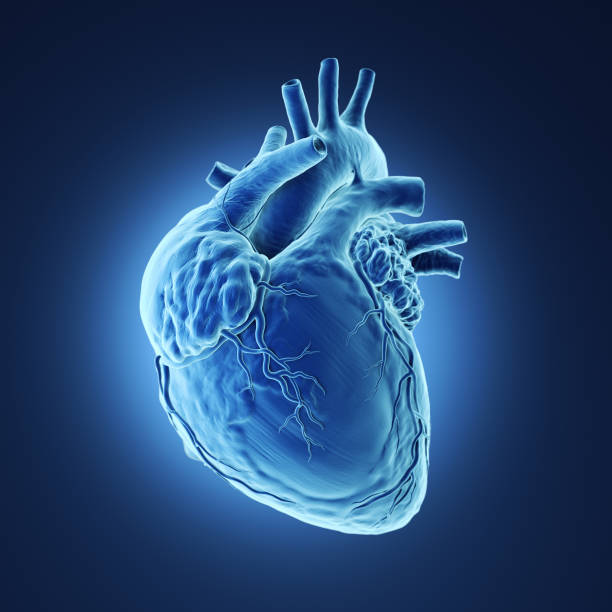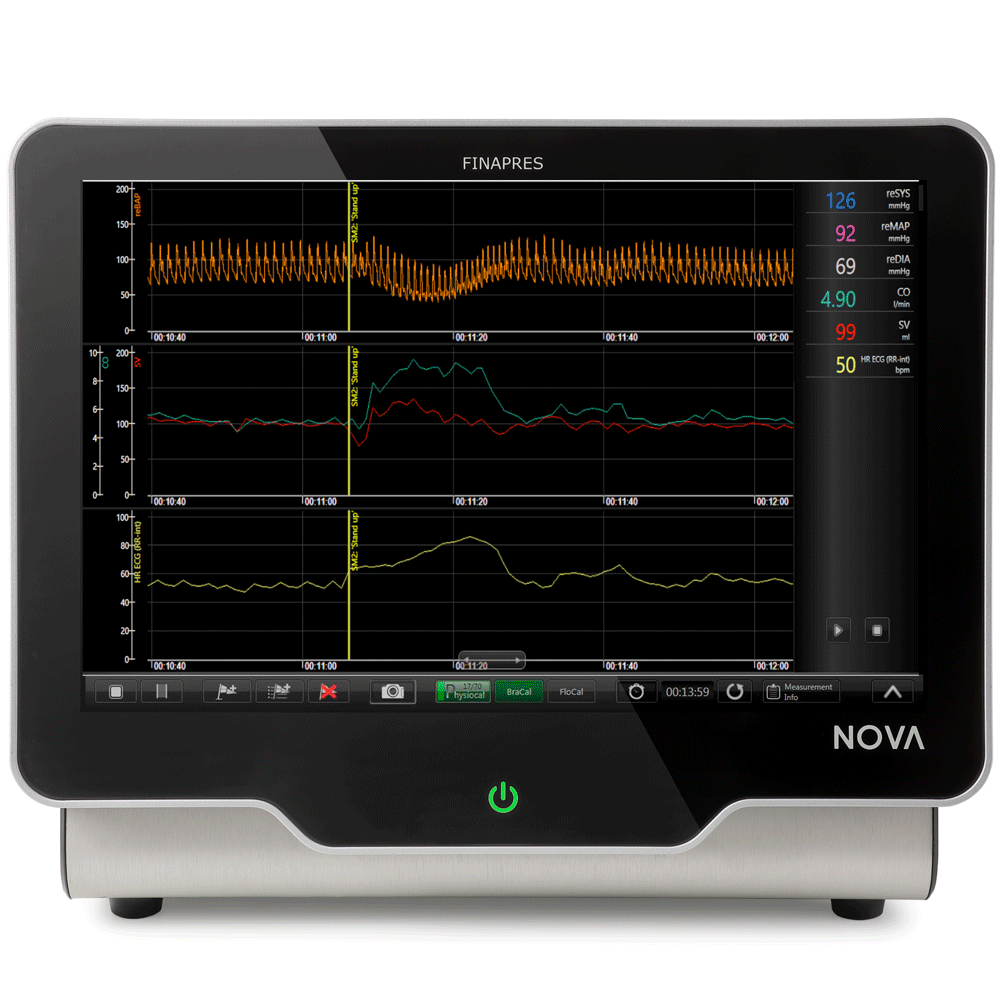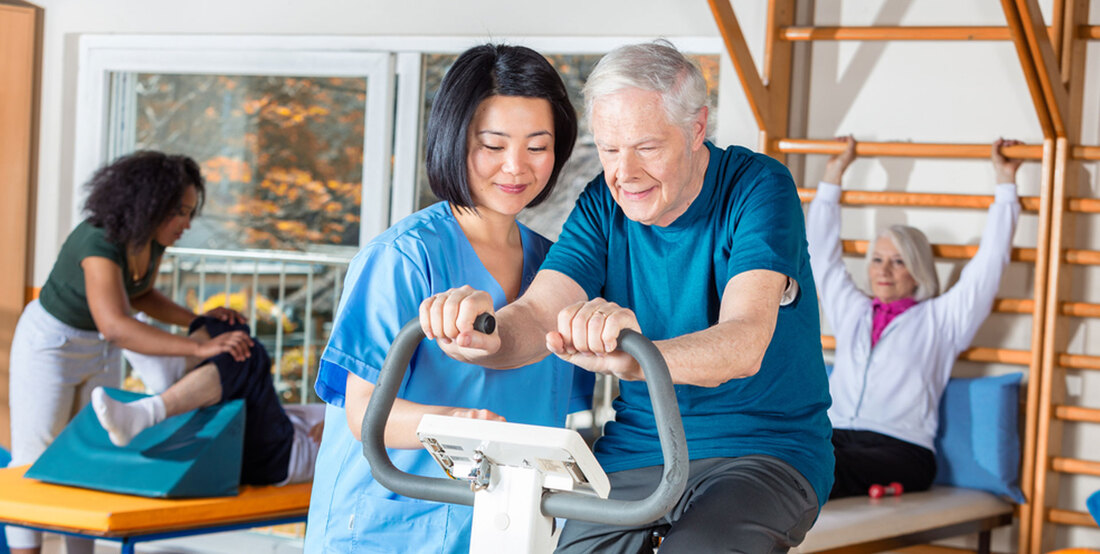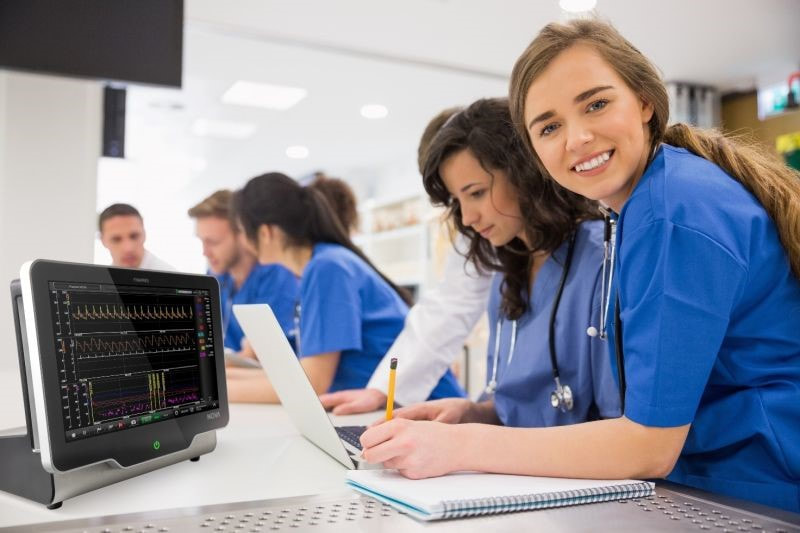|
Application Fields
|
|
Application Field
Hemodynamic Evaluation Did you know that the Finapres® Advanced Hemodynamics application derives 18 cardiovascular parameters non-invasively and continuously, just from the finger cuff signal? Hemodynamic evaluation plays a major role in a multitude of medical specializations. Neurologists, cardiologists, sports physiologists as well as other caregivers can have a special interest in a hemodynamic evaluation of their patients, as this may shed light on their cardiovascular physiology and potential diseases. Our Advanced Hemodynamics (HD) software application provides 18 unique cardiovascular parameters, including Stroke Volume (SV), Cardiac Output (CO) and Total Peripheral Resistance (TPR). These parameters support health care professionals and researchers in studying and diagnosing their patients! |
|
MODELFLOW® ALGORITHM ENABLES CONTINUOUS MEASUREMENT OF SEVERAL HEMODYNAMIC PARAMETERS!
The HD software application uses a statistical model of the human circulation, called Modelflow®, to calculate hemodynamic parameters from the finger arterial pressure waveform. The algorithm computes the aortic flow waveform by simulating a non-linear three-element model of aortic input impedance [1]. The aortic impedance is modelled based on the age, length, weight and gender of the patient, while the systemic vascular resistance is predicted from the mean pressure and model mean flow. Since the development in the 90’s, more than 250 peer-reviewed papers have been published using Modelflow®. |
Stroke Volume (SV), Cardiac Output (CO) and Total Peripheral Resistance (TPR) can be derived non-invasively with Modelflow®!
The SV is the volume of blood pumped from the left ventricle per heartbeat, while the CO is the product of this SV and the Heart Rate (HR, in number of beats per minute). The TPR is the resistance that must be overcome to push blood trough the circulatory system and create blood flow. The TPR parameter is derived from the Mean Arterial Pressure (MAP) divided by CO.
These cardiovascular parameters are related to each other and other physiological characteristics. For example, the CO is dependent on the HR, contractility, preload and afterload. When interpreting CO values, it is important to understand the applicability and practical relevance of each of these four components, as described in a paper from 2008 by Vincent [2].
It has been shown that with the Modelflow® method, beat-to-beat changes in CO are reliably followed [3]. And after calibration by thermodilution, the Modelflow® method can quantitatively replace further thermodilution estimates. [4]
The SV is the volume of blood pumped from the left ventricle per heartbeat, while the CO is the product of this SV and the Heart Rate (HR, in number of beats per minute). The TPR is the resistance that must be overcome to push blood trough the circulatory system and create blood flow. The TPR parameter is derived from the Mean Arterial Pressure (MAP) divided by CO.
These cardiovascular parameters are related to each other and other physiological characteristics. For example, the CO is dependent on the HR, contractility, preload and afterload. When interpreting CO values, it is important to understand the applicability and practical relevance of each of these four components, as described in a paper from 2008 by Vincent [2].
It has been shown that with the Modelflow® method, beat-to-beat changes in CO are reliably followed [3]. And after calibration by thermodilution, the Modelflow® method can quantitatively replace further thermodilution estimates. [4]
|
Application fields for hemodynamic evaluation
Finapres® devices combined with the non-invasive & continuous Modelflow® method are often used for cardiovascular evaluation in various applications, including:
|
References
- Wesseling, K.H. et al. “Computation of aortic flow from pressure in humans using a nonlinear, three-element model.” Journal of applied physiology 74.5 (1993): 2566-2573.
- Vincent J. L. “Understanding cardiac output.” Critical care 12.4 (2008): 1-3.
- Harms, M.P.M. et al. “Continuous stroke volume monitoring by modelling flow from non-invasive measurement of arterial pressure in humans under orthostatic stress.” Clinical Science 97.3 (1999): 291-301.
- Jansen, J.R.C. et al. “A comparison of cardiac output derived from the arterial pressure wave against thermodilution in cardiac surgery patients.” British journal of anaesthesia 87.2 (2001): 212-222.
- Van Dijk, N. et al. “Hemodynamic effects of leg crossing and skeletal muscle tensing during free standing in patients with vasovagal syncope.” Journal of Applied Physiology 98.2 (2005): 584-590.
- Krediet, P. et al. “Syncope during exercise, documented with continuous blood pressure monitoring during ergometer testing.” Clinical Autonomic Research 15.1 (2005): 59-62.
- Claydon, V. E et al. “Water drinking improves orthostatic tolerance in patients with posturally related syncope.” Clinical science 110.3 (2006): 343-352.
- Stewart, J.M. et al. “When Sinus Tachycardia Becomes Too Much: Negative Effects of Excessive Upright Tachycardia on Cardiac Output in Vasovagal Syncope, Postural Tachycardia Syndrome, and Inappropriate Sinus Tachycardia.” Circulation: Arrhythmia and Electrophysiology 13.2 (2020): e007744.
- Babcock, M.C. et al. “High salt intake augments blood pressure responses during submaximal aerobic exercise.” Journal of the American Heart Association 9.10 (2020): e015633.
- Suzuki, K. et al. “Habitual cigarette smoking attenuates shear‐mediated dilation in the brachial artery but not in the carotid artery in young adults.” Physiological reports 8.3 (2020): e14369.
- Pallubinsky, H. et al. “Passive exposure to heat improves glucose metabolism in overweight humans.” Acta Physiologica 229.4 (2020): e13488.
Müller, R.M., Bundgaard-Nielsen, M., and H. Kehlet. “Orthostatic function and the cardiovascular response to early mobilization after breast cancer surgery.” British journal of anaesthesia 104.3 (2010): 298-304. - Hodgson, Y., & J. Choate. “Continuous and noninvasive recording of cardiovascular parameters with the Finapres finger cuff enhances undergraduate student understanding of physiology.” Advances in physiology education 36.1 (2012): 20-26.
|
|
